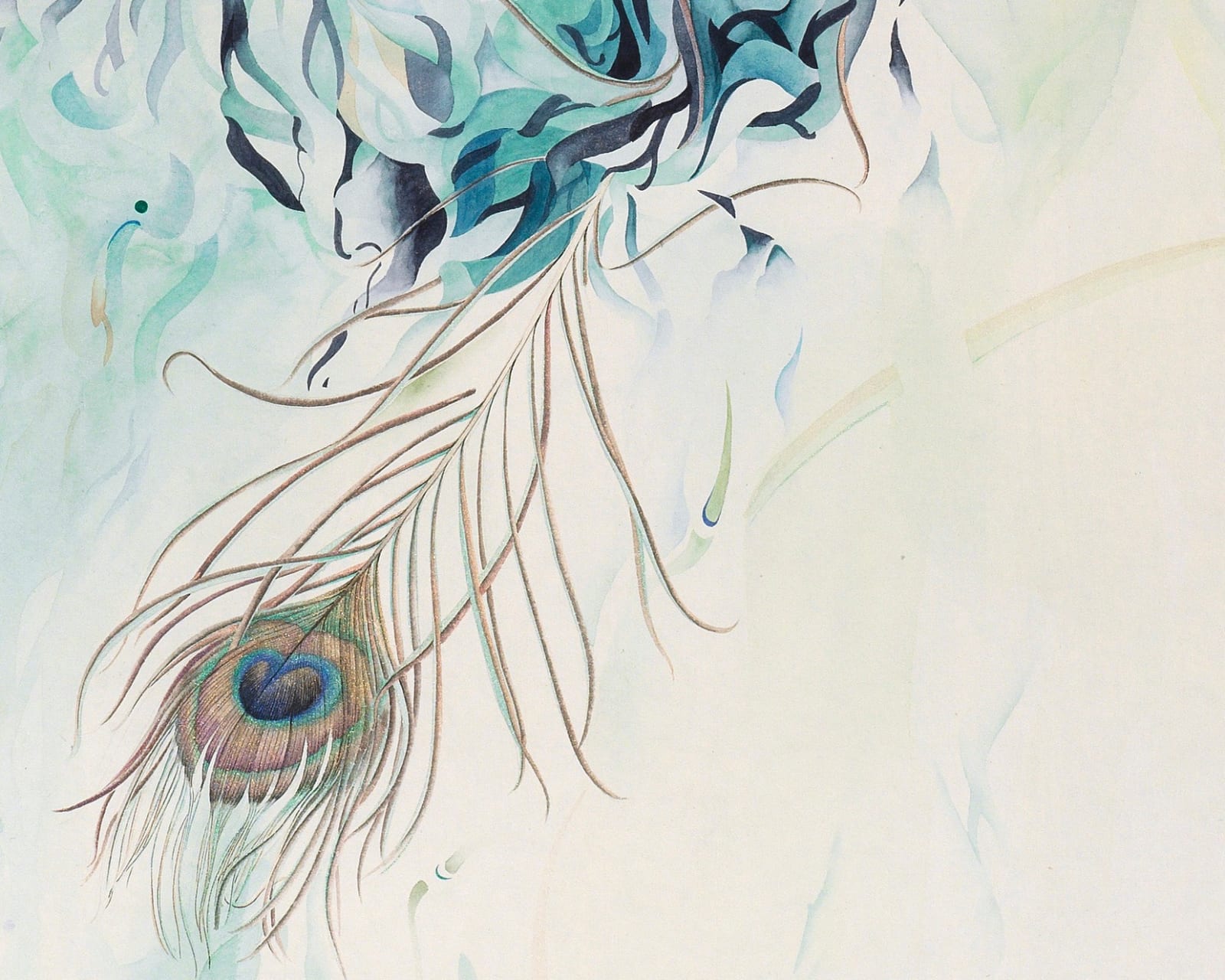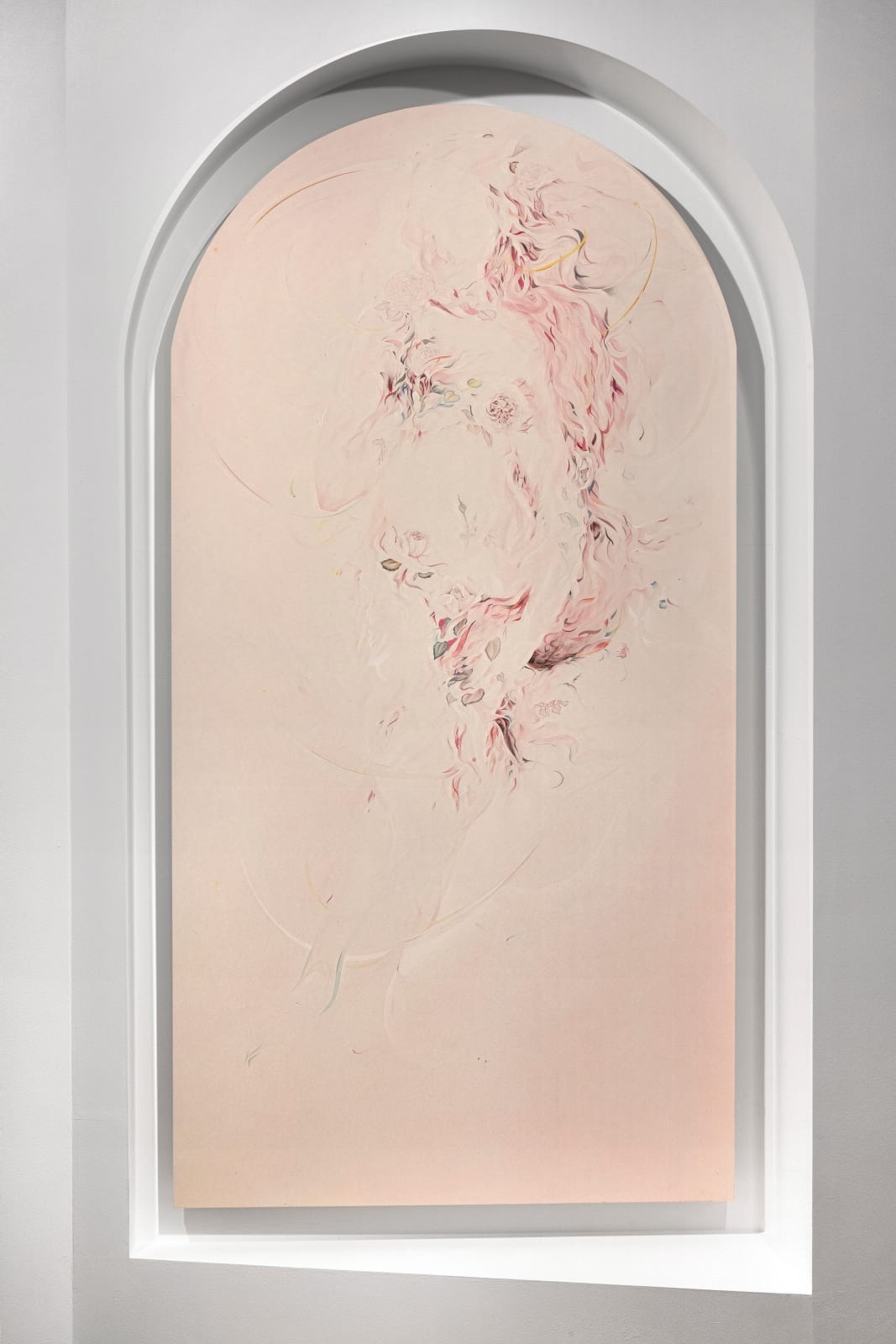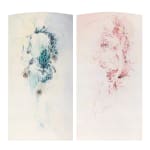Kang Chunhui 康春慧
The Hidden Protagonist No.2 (diptych) 隐逸的主角 No.2 (对屏画), 2022-2024
Ink and mineral pigment on paper
水墨 矿物颜料 宣纸
水墨 矿物颜料 宣纸
200 x 103 cm x 2
78 3/4 x 40 1/2 in x 2
78 3/4 x 40 1/2 in x 2
Copyright The Artist
Further images
Started in 2022, prior to her journey to Xinjiang, the diptych The Hidden Protagonist No. 2 was completed in 2024 after three years of meticulous development. This monumental piece serves...
Started in 2022, prior to her journey to Xinjiang, the diptych The Hidden Protagonist No. 2 was completed in 2024 after three years of meticulous development. This monumental piece serves as a culmination of several recurring conceptual and structural themes within Kang Chunhui's oeuvre, drawing inspiration from diverse sources such as European mythology, formal transmutation, chromatic experimentation, and sacred architecture. The diptych presents two paintings arranged back-to-back, resembling sculptural pieces in the space. Their arched steles or altarpiece-like formation evokes associations with religious paintings commonly found in Buddhist caves or Western churches, albeit in contemporary renditions.
At first glance, the subjects of the two works, one predominantly infused with shades of green and blue, and the other with red and yellow, present themselves as semi-abstract, ethereal elements in motion. However, upon closer examination, discerning observers begin to identify standing human figures, one in each painting. Mirroring the formal transformations observed in Kang's recent works featuring bird figures, distinctive facial or other bodily features are deliberately left indistinct, revealing only the essential vitality of human existence - manifested as the representation of a man and a woman, respectively depicted in each painting. The inspiration for this piece is drawn from iconic pictorial references of the past, particularly Sandro Botticelli's renowned works such as "St. Sebastian" (1473) and "The Birth of Venus" (1484-1485).
What truly captivates Kang Chunhui is the depiction of the dynamic vitality of human nature rather than the specific identity of the subject. Venus embodies birth and life, while St. Sebastian personifies the figure of the dying martyr - one represents an unorthodox and enigmatic path to existence, while the other embodies the tragedy of sacrifice.
What's intriguing to note here is the criterion by which the artist selects her subjects. The renowned art historical reference serves as a tool to facilitate the progressive identification of a familiar subject through visually trained neural patterns, serving as a vehicle for the exploration of existential themes. According to Greek mythology, Venus-Aphrodite's birth is attributed to the foam created when Uranus's severed genitals were thrown into the ocean by his son Cronus. Already in an adult form, Venus emerged from this foam, symbolizing a break from destruction and the birth of freedom. This unique origin story underscores her significance in various cultural contexts. In Chinese classical literature, such as "洛神赋" (Luoshen Fu), which translates to "Ode to the Goddess of the Luo River," themes of femininity and physical form are explored, though often without a clear depiction of the female body, which disappears under the draping of the clothing.(1) In Kang Chunhui's perception, the Goddess of the Luo River embodies a poignant allegory akin to Venus, symbolizing personal feminine freedom and liberation.
In the case of the male figure, Kang chose to depict an emblem of sacrifice, a motif commonly found in Chinese literature. Unlike her method with Venus, she chose a Botticelli painting exploring sacrifice without the need for a specific figure. To maintain visual coherence, the artist unified the chosen figures for consistency in the artwork. As a Chinese counterpart, Kang Chunhui initially imagined representing the spirit of sacrifice via the depiction of the horses appearing in Six Steeds of Zhao Mausoleum from the Tang Dynasty, whose bodies were pierced by arrows similar to those of St. Sebastian.(2) In the portrayal of San Sebastian, embodying the essence of sacrifice, the six horses also symbolize this selfless act, offering themselves willingly for their master. In the final work, the arrows stuck out of St. Sebastian are exquisitely transposed as soft peacock feathers, a formal transformation that mitigates the pathos of the depicted scene.
(1), "洛神赋" ("Luoshen Fu") can be translated as "Ode to Nymph of the Luo River" or "Ode the Goddess of the Luo River". It's a famous Chinese poem written by Cao Zhi (AD 192-232) during the Three Kingdoms period. A well-known depiction of the story can be found in a handscroll painting from the Song Dynasty, currently held by the British Museum.
(2), The Six Steeds of Zhao Mausoleum are six Tang Chinese stone reliefs of horses that were originally located in the Zhao Mausoleum, Shaanxi, China. The Zhao Mausoleum is the burial site of Emperor Taizong of the Tang Dynasty (618-907). The steeds were six valuable war horses ridden by Taizong during the early campaigns to reunify China under the Tang Dynasty.
《隐逸的主角No.2》是一幅对屏画,康春慧在新疆之旅前的2022年开始创作,经过三年的精心构思与描绘,于2024年完成。这件巨幅对屏标志着康春慧作品中几个反复出现的概念和结构主题的巅峰,体现出不同的灵感来源,包括:欧洲神话,形变,色彩实验,以及神圣建筑等。这幅对屏画呈现了两幅背对背陈列的画作,仿佛三维空间中的立体雕塑作品。尽管画作本身是艺术家的当代诠释,它们拱形碑或类似祭坛画般的结构则使人联想到佛教石窟或西方教堂中常见的宗教绘画。
初看之下,两幅作品的主题,其中一幅以蓝、绿色调为主,另一幅以红、黄色调为主,呈现出半抽象、空灵的动态元素。然而,驻足近观,敏锐的观者渐渐能够看出每幅画中均有一个站立的人物形象。但画面中人物的面部和其他身体部位的特征却被刻意模糊化(这与康春慧近期以鸟为主题的作品中所见的形式转化遥相呼应),只保留了人类存在最根本的生命力--分别表现为一位男子和一位女子的形象。两个人物形象的灵感源于标志性的经典绘画图像--波提切利的名作《圣塞巴斯蒂安》(1473)以及《维纳斯的诞生》(1484-1485)。
然而,令康春慧真正着迷的并不是这些人物形象的具体身份,而是对充满动态生命力的人性本质的描绘。维纳斯象征着诞生与生命,而圣塞巴斯蒂安则表现了殉道者的形象--一个代表着非正统且充满神秘色彩的诞生之路,而另一个则体现了牺牲的精神。
这里值得注意的是艺术家选择人物形象的标准。对著名艺术作品的参考和引用作为一种工具,通过视觉训练的神经模式帮助观者逐步识别熟悉的主题。根据希腊神话,维纳斯-阿佛洛狄忒的诞生源于克洛诺斯将父亲乌拉诺斯的生殖器割下并扔入大海时产生的泡沫。维纳斯以成年女子的形态从泡沫中出现,象征着摆脱破坏和自由的诞生。这个独特的起源故事强调了她在不同文化背景下的重要性。中国传统文学作品,如曹植的《洛神赋》中(1),亦可见对女性及身体形态相关主题的探索,尽管通常没有对女性身体的清晰描绘(因其通常隐藏在垂坠的衣裙之下)。对康春慧来说,洛神如同维纳斯一样有着凄美的寓意,象征着女性的个人自由与解放。对于男性人物,康春慧选择了牺牲的象征,这也是中国文学中常见的主题。与对维纳斯的处理方式不同,她选择了波提切利的画作来探索牺牲,却不需要一个具体的人物。为了保持视觉上的连贯性,艺术家统一了所选人物,以确保作品的一致性。康春慧最初设想过使用中国的形象,通过描绘唐代《昭陵六骏》中的战马来表现牺牲精神,战马与圣塞巴斯蒂安一样,都身中数箭,伤痕累累。(2)圣塞巴斯蒂安的形象体现了牺牲的本质,昭陵六骏也象征着无私的奉献,甘愿为主赴死。在最终的画作中,圣塞巴斯蒂安身上的箭头被巧妙地转换为柔软的孔雀羽毛,这种形式上的转变减轻了所绘场景的悲伤与惨烈。
(1)《洛神赋》是三国时期曹植(192-232)创作的著名辞赋。其中一幅为人熟知的《洛神赋图》手卷(宋代摹本)现藏于英国大英博物馆。
(2)《昭陵六骏》是最初位于中国陕西昭陵的六幅大型浮雕石刻,分别刻画六匹中箭的战马。昭陵是唐太宗(618-907)的陵墓。这些战马是唐太宗在早期统一中国时所骑的六匹珍贵战马。
At first glance, the subjects of the two works, one predominantly infused with shades of green and blue, and the other with red and yellow, present themselves as semi-abstract, ethereal elements in motion. However, upon closer examination, discerning observers begin to identify standing human figures, one in each painting. Mirroring the formal transformations observed in Kang's recent works featuring bird figures, distinctive facial or other bodily features are deliberately left indistinct, revealing only the essential vitality of human existence - manifested as the representation of a man and a woman, respectively depicted in each painting. The inspiration for this piece is drawn from iconic pictorial references of the past, particularly Sandro Botticelli's renowned works such as "St. Sebastian" (1473) and "The Birth of Venus" (1484-1485).
What truly captivates Kang Chunhui is the depiction of the dynamic vitality of human nature rather than the specific identity of the subject. Venus embodies birth and life, while St. Sebastian personifies the figure of the dying martyr - one represents an unorthodox and enigmatic path to existence, while the other embodies the tragedy of sacrifice.
What's intriguing to note here is the criterion by which the artist selects her subjects. The renowned art historical reference serves as a tool to facilitate the progressive identification of a familiar subject through visually trained neural patterns, serving as a vehicle for the exploration of existential themes. According to Greek mythology, Venus-Aphrodite's birth is attributed to the foam created when Uranus's severed genitals were thrown into the ocean by his son Cronus. Already in an adult form, Venus emerged from this foam, symbolizing a break from destruction and the birth of freedom. This unique origin story underscores her significance in various cultural contexts. In Chinese classical literature, such as "洛神赋" (Luoshen Fu), which translates to "Ode to the Goddess of the Luo River," themes of femininity and physical form are explored, though often without a clear depiction of the female body, which disappears under the draping of the clothing.(1) In Kang Chunhui's perception, the Goddess of the Luo River embodies a poignant allegory akin to Venus, symbolizing personal feminine freedom and liberation.
In the case of the male figure, Kang chose to depict an emblem of sacrifice, a motif commonly found in Chinese literature. Unlike her method with Venus, she chose a Botticelli painting exploring sacrifice without the need for a specific figure. To maintain visual coherence, the artist unified the chosen figures for consistency in the artwork. As a Chinese counterpart, Kang Chunhui initially imagined representing the spirit of sacrifice via the depiction of the horses appearing in Six Steeds of Zhao Mausoleum from the Tang Dynasty, whose bodies were pierced by arrows similar to those of St. Sebastian.(2) In the portrayal of San Sebastian, embodying the essence of sacrifice, the six horses also symbolize this selfless act, offering themselves willingly for their master. In the final work, the arrows stuck out of St. Sebastian are exquisitely transposed as soft peacock feathers, a formal transformation that mitigates the pathos of the depicted scene.
(1), "洛神赋" ("Luoshen Fu") can be translated as "Ode to Nymph of the Luo River" or "Ode the Goddess of the Luo River". It's a famous Chinese poem written by Cao Zhi (AD 192-232) during the Three Kingdoms period. A well-known depiction of the story can be found in a handscroll painting from the Song Dynasty, currently held by the British Museum.
(2), The Six Steeds of Zhao Mausoleum are six Tang Chinese stone reliefs of horses that were originally located in the Zhao Mausoleum, Shaanxi, China. The Zhao Mausoleum is the burial site of Emperor Taizong of the Tang Dynasty (618-907). The steeds were six valuable war horses ridden by Taizong during the early campaigns to reunify China under the Tang Dynasty.
《隐逸的主角No.2》是一幅对屏画,康春慧在新疆之旅前的2022年开始创作,经过三年的精心构思与描绘,于2024年完成。这件巨幅对屏标志着康春慧作品中几个反复出现的概念和结构主题的巅峰,体现出不同的灵感来源,包括:欧洲神话,形变,色彩实验,以及神圣建筑等。这幅对屏画呈现了两幅背对背陈列的画作,仿佛三维空间中的立体雕塑作品。尽管画作本身是艺术家的当代诠释,它们拱形碑或类似祭坛画般的结构则使人联想到佛教石窟或西方教堂中常见的宗教绘画。
初看之下,两幅作品的主题,其中一幅以蓝、绿色调为主,另一幅以红、黄色调为主,呈现出半抽象、空灵的动态元素。然而,驻足近观,敏锐的观者渐渐能够看出每幅画中均有一个站立的人物形象。但画面中人物的面部和其他身体部位的特征却被刻意模糊化(这与康春慧近期以鸟为主题的作品中所见的形式转化遥相呼应),只保留了人类存在最根本的生命力--分别表现为一位男子和一位女子的形象。两个人物形象的灵感源于标志性的经典绘画图像--波提切利的名作《圣塞巴斯蒂安》(1473)以及《维纳斯的诞生》(1484-1485)。
然而,令康春慧真正着迷的并不是这些人物形象的具体身份,而是对充满动态生命力的人性本质的描绘。维纳斯象征着诞生与生命,而圣塞巴斯蒂安则表现了殉道者的形象--一个代表着非正统且充满神秘色彩的诞生之路,而另一个则体现了牺牲的精神。
这里值得注意的是艺术家选择人物形象的标准。对著名艺术作品的参考和引用作为一种工具,通过视觉训练的神经模式帮助观者逐步识别熟悉的主题。根据希腊神话,维纳斯-阿佛洛狄忒的诞生源于克洛诺斯将父亲乌拉诺斯的生殖器割下并扔入大海时产生的泡沫。维纳斯以成年女子的形态从泡沫中出现,象征着摆脱破坏和自由的诞生。这个独特的起源故事强调了她在不同文化背景下的重要性。中国传统文学作品,如曹植的《洛神赋》中(1),亦可见对女性及身体形态相关主题的探索,尽管通常没有对女性身体的清晰描绘(因其通常隐藏在垂坠的衣裙之下)。对康春慧来说,洛神如同维纳斯一样有着凄美的寓意,象征着女性的个人自由与解放。对于男性人物,康春慧选择了牺牲的象征,这也是中国文学中常见的主题。与对维纳斯的处理方式不同,她选择了波提切利的画作来探索牺牲,却不需要一个具体的人物。为了保持视觉上的连贯性,艺术家统一了所选人物,以确保作品的一致性。康春慧最初设想过使用中国的形象,通过描绘唐代《昭陵六骏》中的战马来表现牺牲精神,战马与圣塞巴斯蒂安一样,都身中数箭,伤痕累累。(2)圣塞巴斯蒂安的形象体现了牺牲的本质,昭陵六骏也象征着无私的奉献,甘愿为主赴死。在最终的画作中,圣塞巴斯蒂安身上的箭头被巧妙地转换为柔软的孔雀羽毛,这种形式上的转变减轻了所绘场景的悲伤与惨烈。
(1)《洛神赋》是三国时期曹植(192-232)创作的著名辞赋。其中一幅为人熟知的《洛神赋图》手卷(宋代摹本)现藏于英国大英博物馆。
(2)《昭陵六骏》是最初位于中国陕西昭陵的六幅大型浮雕石刻,分别刻画六匹中箭的战马。昭陵是唐太宗(618-907)的陵墓。这些战马是唐太宗在早期统一中国时所骑的六匹珍贵战马。












